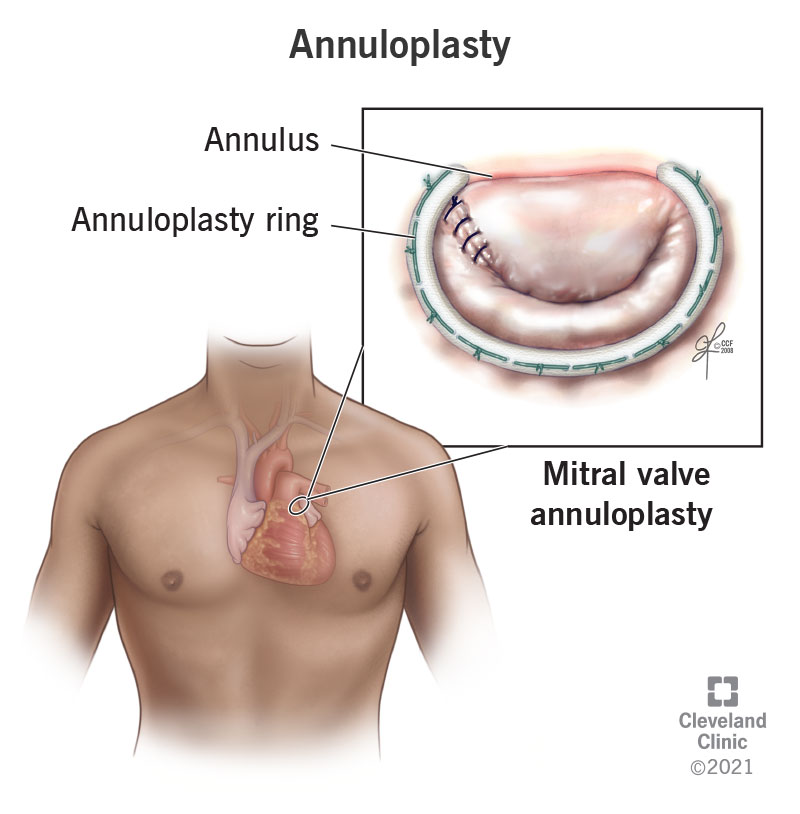An annuloplasty is a procedure to treat a leaky heart valve. During annuloplasty, your provider places a small ring around the leaky valve. The permanent ring reinforces or tightens the valve. Often, providers use a minimally invasive approach to perform an annuloplasty.
Advertisement
Cleveland Clinic is a non-profit academic medical center. Advertising on our site helps support our mission. We do not endorse non-Cleveland Clinic products or services. Policy
An annuloplasty is a procedure to repair or reinforce a heart valve. With annuloplasty, a surgeon places a band around the ring that surrounds your heart valve (annulus). This band reinforces the ring to help your heart valve close as tightly as it should.
Advertisement
Cleveland Clinic is a non-profit academic medical center. Advertising on our site helps support our mission. We do not endorse non-Cleveland Clinic products or services. Policy
Your heart valves open and close to send blood through your heart. If a valve doesn’t close correctly, blood may leak backward and your heart may not pump blood as efficiently through your body.
Sometimes, leaky heart valves cause mild symptoms. But they can also lead to complications such as heart failure or sudden cardiac arrest. If your healthcare provider diagnoses a leaky heart valve, it’s important to get treatment.
During annuloplasty, surgeons place a ring-like device around your heart valve. The ring may be mesh, metal or plastic. The ring mimics your heart valve’s natural movement and flexibility. It stays in place permanently and helps the valve open and close properly.
You may need an annuloplasty if you have a leaky heart valve (valve regurgitation). Healthcare providers can perform an annuloplasty on any heart valve. You may need one of several types of annuloplasty to treat valve regurgitation:
No. Your provider may use other treatments for valve regurgitation. For example, a common minimally invasive treatment for mitral valve disease is surgery to place a MitraClip®.
Advertisement
The MitraClip is a small clip that helps the mitral valve close tightly. Providers place the MitraClip using small incisions and a small, hollow tube (catheter) through your groin.
Annuloplasty is a procedure to tighten a leaky heart valve. Valvuloplasty is a procedure to open a narrowed heart valve (stenosis).
Healthcare providers can perform both procedures using minimally invasive techniques. Minimally invasive treatments use tiny incisions, tools and cameras. Compared to open surgery, they often lead to quicker recovery and a lower risk of complications.

Your healthcare provider will give you specific instructions to prepare for an annuloplasty. You will likely have to fast (not drink or eat) before the procedure, usually starting the night before.
If you have bleeding risks, let your provider know. If you take blood-thinning medicines (anticoagulants) you may have to stop taking them temporarily before the procedure.
Cardiac surgeons (surgeons specializing in the heart) perform annuloplasties. They can use either open-heart surgery or minimally invasive techniques. Both procedures use general anesthesia so you stay asleep during treatment.
In open-heart annuloplasty, your surgeon will:
In minimally invasive annuloplasty, your surgeon will:
After the procedure, you spend a few hours in a recovery area. If you had minimally invasive annuloplasty, you can usually return home in one to two days. After open heart annuloplasty, you may need to stay in the hospital for up to seven days.
An annuloplasty reinforces a leaky heart valve. It improves blood flow through your heart and helps your heart pump blood more efficiently. For many people, the results last a lifetime.
Annuloplasties are generally safe procedures. As with any surgery, annuloplasty has a risk of postsurgical infection or bleeding.
Your overall risks depend on several factors, including your health and heart condition. Your healthcare provider can help you understand the specific risks and possible complications of an annuloplasty.
Advertisement
Your overall recovery time depends on several factors, including whether your healthcare provider used minimally invasive or open techniques.
After an annuloplasty, you’ll need to avoid intense activity for at least a week. You may be able to go back to work within a week or two after the procedure. If you have a job that includes heavy physical activity, you may need to wait longer. Your healthcare provider will give you specific instructions for what to expect during recovery.
Typically, annuloplasty rings last several decades. Most people don’t need a replacement.
Annuloplasty rings are designed to stay in place permanently. Over time, your heart grows around the ring, exactly like it’s supposed to. In a sense, the ring becomes part of your heart.
After annuloplasty, contact your healthcare provider right away if you have:
Annuloplasty is a procedure to reinforce or tighten one of your heart valves. You may need an annuloplasty if you have a leaky valve. During annuloplasty, your provider places a ring around your heart valve to help it close tightly. Healthcare providers may use minimally invasive or open annuloplasty. The type of procedure you have depends on several factors, including your overall health and the condition of your heart. Annuloplasty rings stay in place long-term and typically last several decades.
Advertisement
It can be scary and overwhelming when something is happening with your heart valves. Cleveland Clinic heart specialists are ready to get you the help you need.

Last reviewed on 12/07/2021.
Learn more about the Health Library and our editorial process.